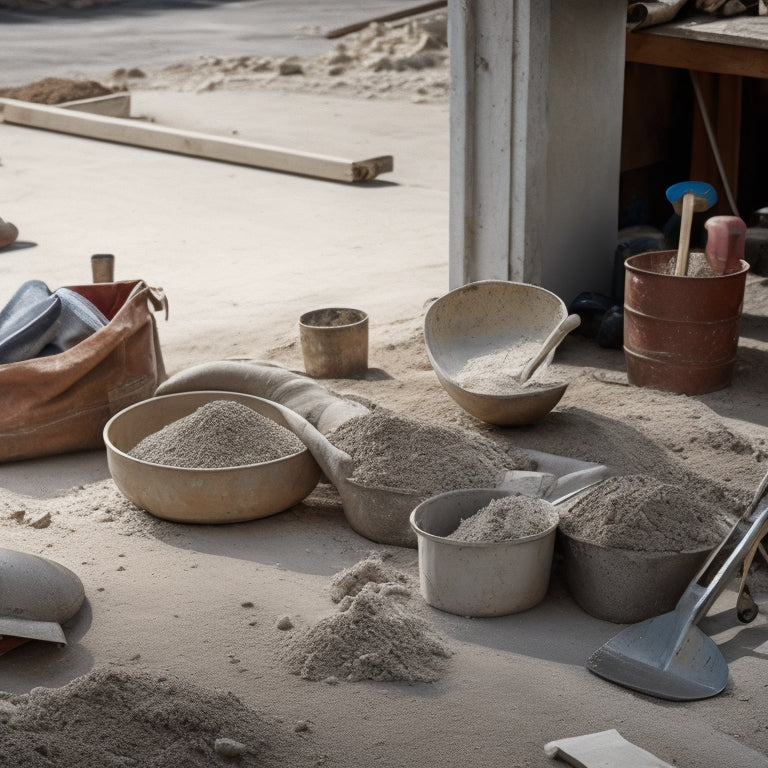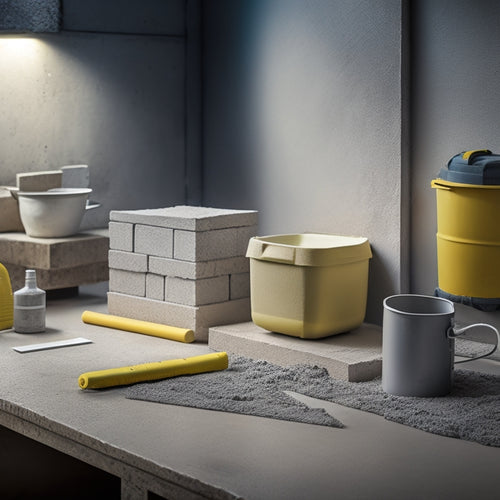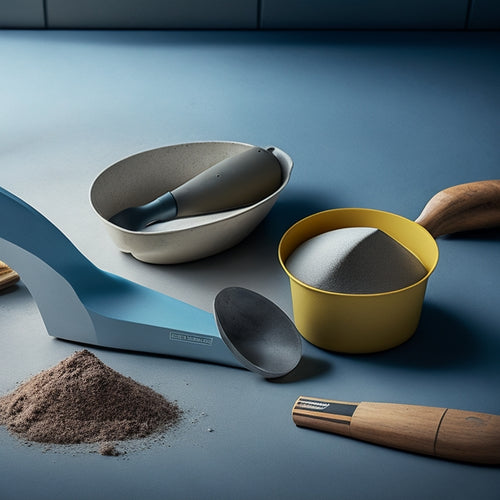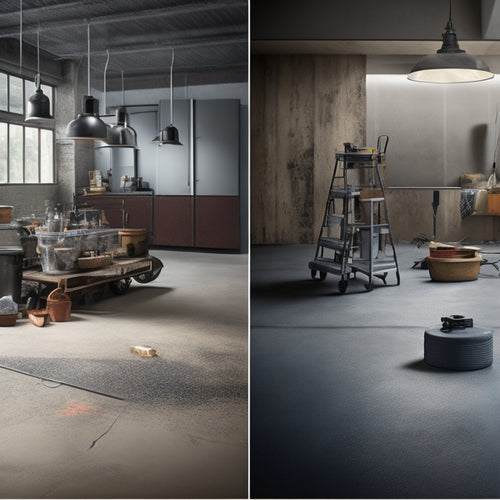
10 Best Concrete Mixing Tools for Beginners
Share
You'll need a solid set of concrete mixing tools to guarantee your DIY projects turn out smooth, strong, and professional-looking. Start with a sturdy mixing bucket, crucial for combining concrete mixtures effectively. A reliable mixing stick, made from materials like wood, aluminum, or plastic, is also essential. Next, invest in a high-quality concrete trowel, finishing trowel, and edger tools for smoothing and shaping concrete. Additional must-haves include a concrete level, screed board, and rake for achieving a perfectly horizontal surface. With these essential tools, you'll be well on your way to a successful project - and discovering the finer details of each tool will take your skills to the next level.
Key Takeaways
• A sturdy, heavy-duty mixing bucket with a minimum capacity of 5 gallons is essential for beginners, with options available in steel, plastic, or fiberglass.
• Mixing sticks made of plastic paddles are ideal for beginners due to their lightweight, rust-resistant, and ergonomic design, reducing fatigue and improving control.
• A reliable concrete trowel is vital for smoothing, finishing, and shaping concrete mixtures, with steel and resin options available, and proper maintenance is crucial to prevent rust.
• Edging and leveling tools, such as concrete edgers and spirit levels, are necessary for creating clean, defined edges and achieving a perfectly horizontal surface.
• Tamping and floating tools, including bull floats and hand tampers, ensure proper consolidation and prevent settlement cracks, with regular maintenance and inspections crucial for tool longevity.
Essential Mixing Bucket Needs
You'll need a sturdy, heavy-duty bucket with a capacity of at least 5 gallons to serve as the foundation for your mixing operation. This is vital, as it will hold the concrete mixture and withstand the rigors of mixing without collapsing or leaking.
When it comes to mixing bucket types, you have options: steel, plastic, or fiberglass. Steel buckets are durable and resistant to scratches, while plastic buckets are lightweight and easy to clean. Fiberglass buckets offer a compromise between the two.
Consider the size of your project and the amount of concrete you'll need to mix when selecting a mixing bucket size. A 5-gallon bucket is a good starting point, but larger projects may require 10-gallon or even 20-gallon buckets. Remember, a larger bucket doesn't always mean better – it's important to choose a size that suits your needs and allows for efficient mixing.
Always prioritize safety when working with concrete, and a sturdy, reliable mixing bucket is the first step in ensuring a successful project.
Reliable Concrete Trowel Options
Selecting a reliable concrete trowel is vital, as it enables you to smooth, finish, and shape the concrete mixture with precision and control.
There are two primary trowel types to take into account: steel and resin. Steel trowels are more durable and suitable for heavy-duty projects, while resin trowels are lighter and better suited for smaller, more intricate tasks.
Regardless of the type you choose, it's important to maintain your trowel properly to guarantee peak performance and extend its lifespan. Regularly clean your trowel with soap and water, and store it in a dry place to prevent rust or damage.
Additionally, inspect your trowel for signs of wear, such as cracks or bent edges, and replace it if necessary. Proper trowel maintenance not only guarantees a smooth finish but also prevents accidents caused by a faulty tool.
Best Mixing Stick Materials
With your trowel in hand and a solid understanding of its role in shaping concrete, it's time to turn your attention to the mixing stick, an essential tool that helps you combine and blend the concrete mixture with ease and consistency. The material you choose can make all the difference.
When selecting a mixing stick, you'll encounter three primary material options: wooden sticks, aluminum rods, and plastic paddles. Each has its unique benefits and drawbacks.
Wooden sticks, for instance, are inexpensive and easy to handle, but they can absorb moisture from the concrete, leading to a weakened structure.
Aluminum rods, on the other hand, are durable and resistant to corrosion, but they can be heavy and may cause fatigue during prolonged mixing.
For a more efficient and safe mixing experience, consider using plastic paddles or mixing blades. These lightweight, rust-resistant materials enable you to mix large quantities of concrete without straining your back or arms.
Plus, they're often designed with ergonomic handles, reducing fatigue and improving control.
Top-Rated Concrete Edger Tools
Finishing the concrete mixture to perfection requires attention to detail, and that's where top-rated concrete edger tools come in. These tools allow you to create clean, defined edges and joints that elevate the overall aesthetic of your project.
When selecting an edger tool, consider the type of edger design that suits your project's requirements. For instance, a radius edger is ideal for curved edges, while a cantilever edger is perfect for creating sharp, 90-degree angles.
To achieve professional-looking results, it's crucial to master various edging techniques. You'll want to practice techniques such as 'floating and edging' and 'edging and jointing' to guarantee a seamless finish.
Top-rated concrete edger tools are designed with safety in mind, featuring ergonomic handles and durable materials that can withstand harsh job site conditions. Look for tools with adjustable handles and comfortable grips to reduce fatigue and improve control.
Beginner-Friendly Floating Tools
You'll need a reliable floating tool to smooth and flatten the concrete surface, ensuring an even finish and proper consolidation of the mixture. As a beginner, it's crucial to choose the right floating tool type for your project.
There are two primary floating tool types: bull floats and fresno trowels. Bull floats are ideal for large, flat areas, while fresno trowels are better suited for smaller, more intricate surfaces. Both tools provide excellent benefits, including improved surface finish, reduced air pockets, and enhanced concrete strength.
When selecting a floating tool, prioritize safety features, such as ergonomic handles and durable materials. Look for tools with a comfortable grip and balanced design to reduce fatigue and improve control.
Additionally, consider the tool's weight and size, ensuring it's easy to maneuver and store. By investing in a high-quality floating tool, you'll achieve a professional-grade finish while minimizing the risk of accidents and injuries.
Must-Have Tamping Tool Kits
Equipped with a reliable floating tool, your next step is to assemble a tamping tool kit that guarantees proper consolidation and prevents settlement cracks in your freshly poured concrete. A well-rounded kit should include a variety of tamping tool types, such as bull floats, hand tampers, and screed boards. Each type serves a specific purpose, and having the right tools guarantees you can tackle different concrete applications with confidence.
Regular tamping tool maintenance is vital to guarantee peak performance and extend the lifespan of your tools. Clean your tools thoroughly after each use, and store them in a dry place to prevent rust.
Perform routine inspections to identify any damage or wear, and replace worn-out parts promptly. Proper maintenance also helps prevent the spread of contaminants, which can affect the quality of your concrete.
Perfect Concrete Rake Choices
When choosing the perfect concrete rake, you'll need to evaluate a few key factors.
You'll want to think about the specific tasks you'll be using the rake for, as well as the type of concrete you're working with.
Rake Selection Criteria
Selecting the right concrete rake involves taking into account several key factors, including the type of concrete, the size of the project, and the desired finish.
As you choose a rake, think about the type of concrete you're working with - is it high-strength, fiber-reinforced, or regular? This will help you determine the rake's material. You'll want a rake made from durable, high-quality materials that can withstand the demands of your project. For instance, a stainless steel or aluminum rake is ideal for heavy-duty projects, while a fiberglass or resin rake may be better suited for smaller, more delicate jobs.
When it comes to rake maintenance, you'll want to reflect on how easy the rake is to clean and store. A rake with a smooth, rust-resistant surface will be easier to maintain and will last longer.
Additionally, look for a rake with a comfortable, non-slip grip to guarantee safe handling. By taking these factors into account, you'll be able to choose a rake that meets your specific needs and helps you achieve a professional-looking finish.
Optimal Rake Angle
You'll achieve a perfect, smooth concrete finish by maintaining an ideal rake angle between 30 and 45 degrees, allowing you to effectively remove excess material and achieve the desired texture. This prime rake angle guarantees that you're not pushing too much concrete forward, which can lead to an uneven finish or, worse, accidents. When you're at the ideal angle, you'll be able to control the flow of concrete and achieve a uniform consistency.
To maintain this prime rake angle, consider investing in a rake with an adjustable head or a tilting handle. This will give you the flexibility to adjust the angle as needed, depending on the specific requirements of your project. Additionally, prioritize rake maintenance tips such as regularly cleaning and inspecting your rake for damage or wear. A well-maintained rake is essential for achieving a professional-looking finish.
When selecting a rake, look for prime rake design features such as a sturdy handle, a durable head, and a comfortable grip. These features will help you maintain control and precision as you work, guaranteeing a smooth and safe concrete finishing experience. By combining the right rake angle with proper maintenance and design, you'll be well on your way to achieving a flawless concrete finish.
High-Quality Finishing Trowels
For achieving a smooth, even finish, invest in a high-quality finishing trowel designed to hold a thin layer of concrete and feature a curved or angled blade that allows for precise control.
You'll find various types of finishing trowels, including stainless steel, carbon steel, and epoxy-coated options. Stainless steel trowels are ideal for working with sensitive materials, while carbon steel trowels provide extra durability. Epoxy-coated trowels offer rust resistance and ease of cleaning.
To guarantee peak performance and extend the lifespan of your finishing trowel, proper maintenance is essential. Regularly clean your trowel with soap and water to prevent concrete buildup.
Store your trowel in a dry place, away from direct sunlight, to prevent rust or damage. Additionally, apply a rust-inhibiting coating to metal blades to maintain their integrity.
Concrete Smoothing Tool Essentials
With your finishing trowel in hand, you're ready to move on to the next step in achieving a flawless concrete finish: employing the right concrete smoothing tools to eliminate imperfections and air pockets.
To master the art of concrete smoothing, you'll need a range of specialized tools that'll help you refine your techniques and produce a high-quality finish. Invest in a set of high-quality edgers, which are designed to remove excess concrete and create a clean, defined edge.
You'll also need a series of tamping tools, including a bull float and a darby, to flatten and smooth out the surface. Don't forget a set of concrete scrapers, which are perfect for removing excess material and achieving a uniform surface.
When it comes to surface preparation, remember to always follow proper smoothing techniques to prevent defects and guarantee a durable finish. Start by removing any excess concrete, followed by a series of gentle, sweeping motions to flatten the surface.
Vital Concrete Leveling Tools
As you engage in concrete mixing, it's essential to master concrete leveling techniques to guarantee a sturdy and even foundation.
Six vital concrete leveling tools are necessary to assure a perfectly horizontal surface, free from dips and humps that can compromise the structural integrity of your concrete project. You'll need a spirit level, a laser level, and a leveling rake to confirm accuracy and precision. A screed board, a bull float, and a darby are also must-haves for smoothing and flattening the concrete.
With these essential leveling equipment, you'll be able to achieve a professional-grade finish. Remember, a level surface is important for safety and structural soundness.
It's not just about aesthetics; uneven concrete can lead to accidents and costly repairs down the line. By investing in the right tools and mastering concrete leveling techniques, you'll be able to create a solid foundation that will last for years to come.
Frequently Asked Questions
Can I Mix Concrete in a Plastic Bucket With Metal Ribs?
You're wondering if you can mix concrete in a plastic bucket with metal ribs. The answer is yes, but with caution.
The metal reinforcement in the bucket won't react with the concrete, but it can create pockets where the mix can settle and not blend properly.
Make certain you scrape the sides and bottom of the bucket thoroughly during mixing to avoid weak spots in your concrete.
How Often Should I Clean My Concrete Mixing Tools?
You should clean your concrete mixing tools after every use to prevent concrete residue from hardening and compromising their performance.
Regular cleaning also reduces the risk of contamination and guarantees your tools remain in good condition.
Aim for a daily cleaning frequency, and perform deeper maintenance tasks, like descaling and lubricating, on a weekly or monthly basis, depending on usage.
This diligent tool maintenance will keep your equipment safe, efficient, and reliable.
Are Concrete Mixing Tools Compatible With All Cement Types?
When working with concrete, you'll encounter various cement types, each with unique properties.
You'll need to guarantee your mixing tools are compatible with the specific type you're using. Not all tools are suitable for every cement type, and using the wrong tool can compromise the mix's integrity.
Consider the mixing techniques required for your project and choose tools designed for that specific application to guarantee a safe and successful outcome.
Can I Use a Power Drill With a Mixing Stick Attachment?
As you plunge into the world of concrete mixing, you'll find yourself wondering if a power drill with a mixing stick attachment is the perfect combo.
The answer is a resounding yes! A power drill offers benefits like speed and efficiency, while mixing stick types vary from helical to paddle designs.
When choosing, prioritize safety by selecting a drill with a comfortable grip and a mixing stick that suits your mixing style.
With the right pair, you'll be mixing like a pro in no time!
Do I Need to Seal My Concrete Tools After Each Use?
You're wise to wonder about maintaining your concrete tools.
After each use, you should always clean and dry your tools to prevent rust and damage.
While sealing them isn't always necessary, it's a good idea to apply a rust-inhibiting sealant to metal tools, especially if you live in a humid climate.
Research sealant options, like silicone or oil-based products, and follow the manufacturer's instructions for application.
Proper tool maintenance will extend the life of your equipment and guarantee your safety on the job.
Conclusion
You've made it to the end of our detailed guide to the 10 best concrete mixing tools for beginners.
Now, it's time to put your newfound knowledge to the test.
Remember, with the right tools, even a novice can achieve professional-grade results.
Take, for instance, the renovation of a 500-square-foot patio, where a beginner contractor used our top-rated edger tool to achieve a seamless jointless finish, impressing even the most discerning clients.
Related Posts
-

What Tools Do I Need for Concrete Block Laying
You'll need a thorough set of tools to guarantee accurate, efficient, and professional concrete block laying. Essenti...
-

Ergonomic Concrete Tools for Tight Spaces
When you're tackling concrete work in tight spaces, ergonomic tools are your best bet for comfort and efficiency. The...
-

Top Tools for Revamping Old Concrete Floors
You'll need a range of tools to revamp your old concrete floor, starting with epoxy, acrylic, or polyurethane paint, ...


